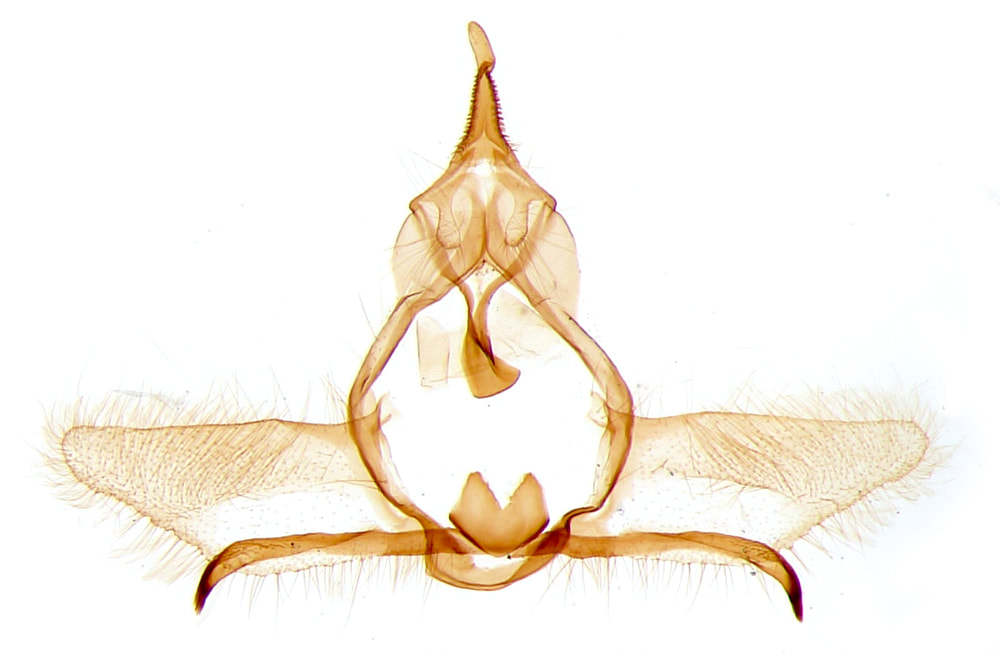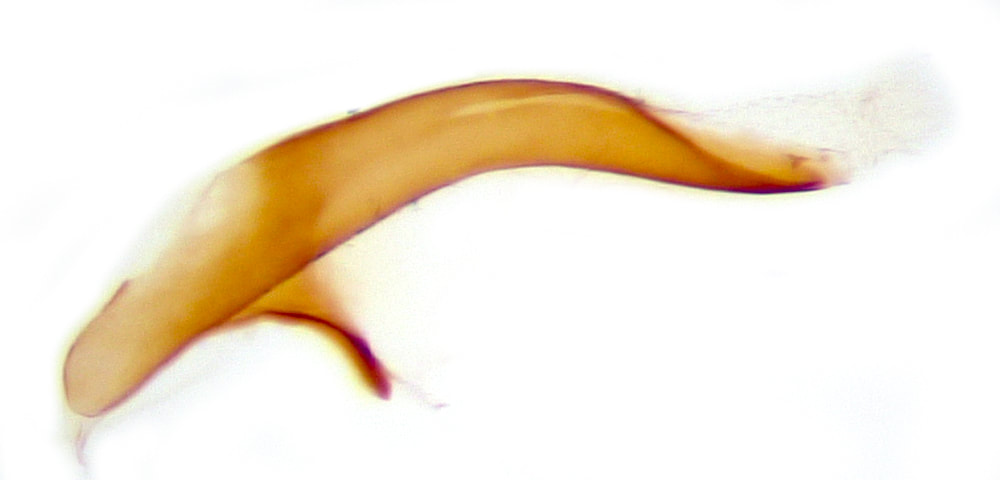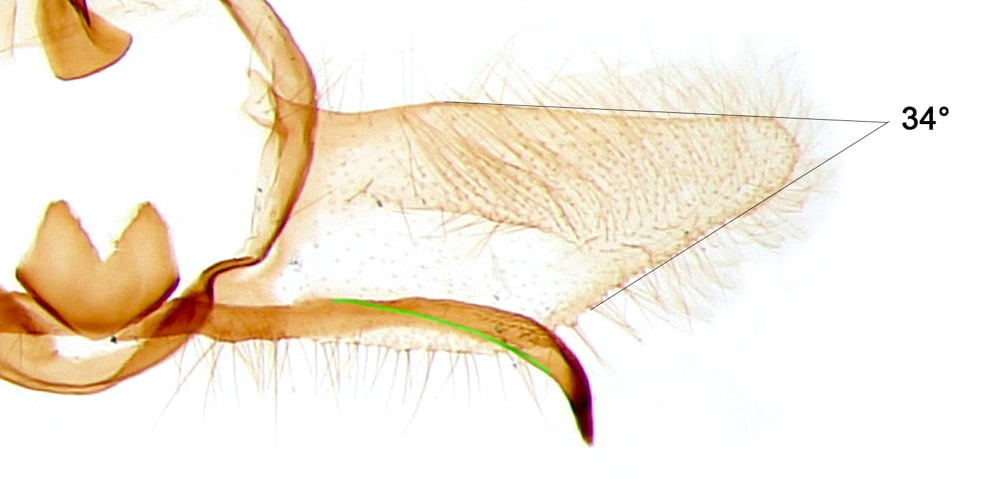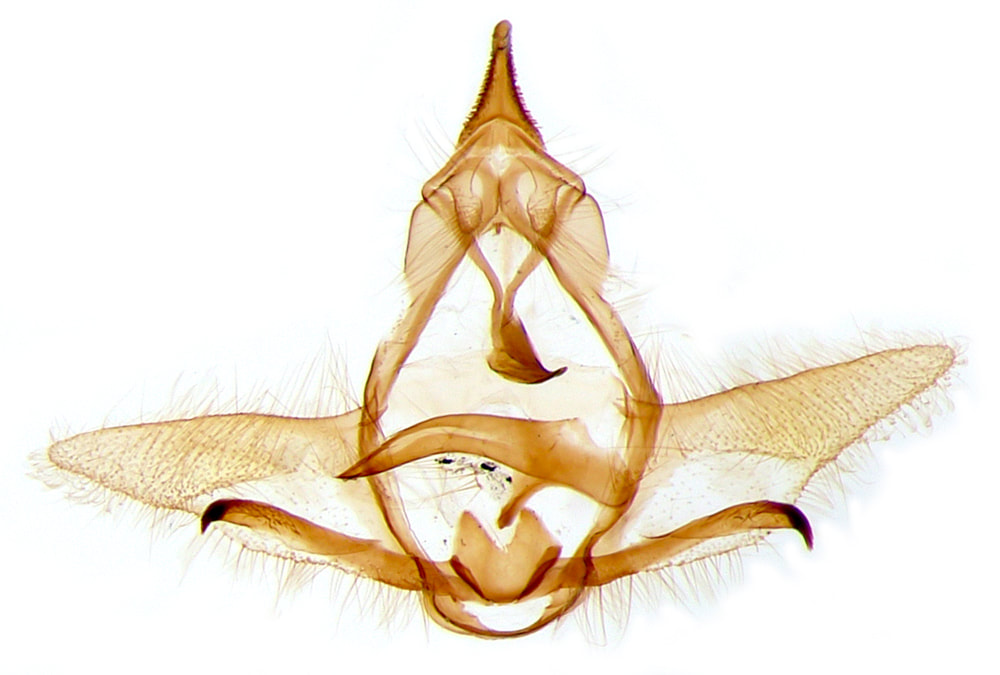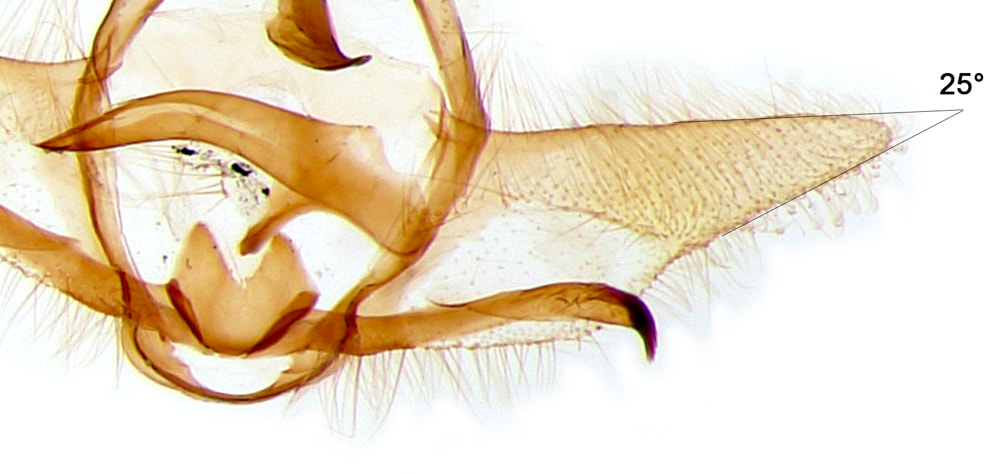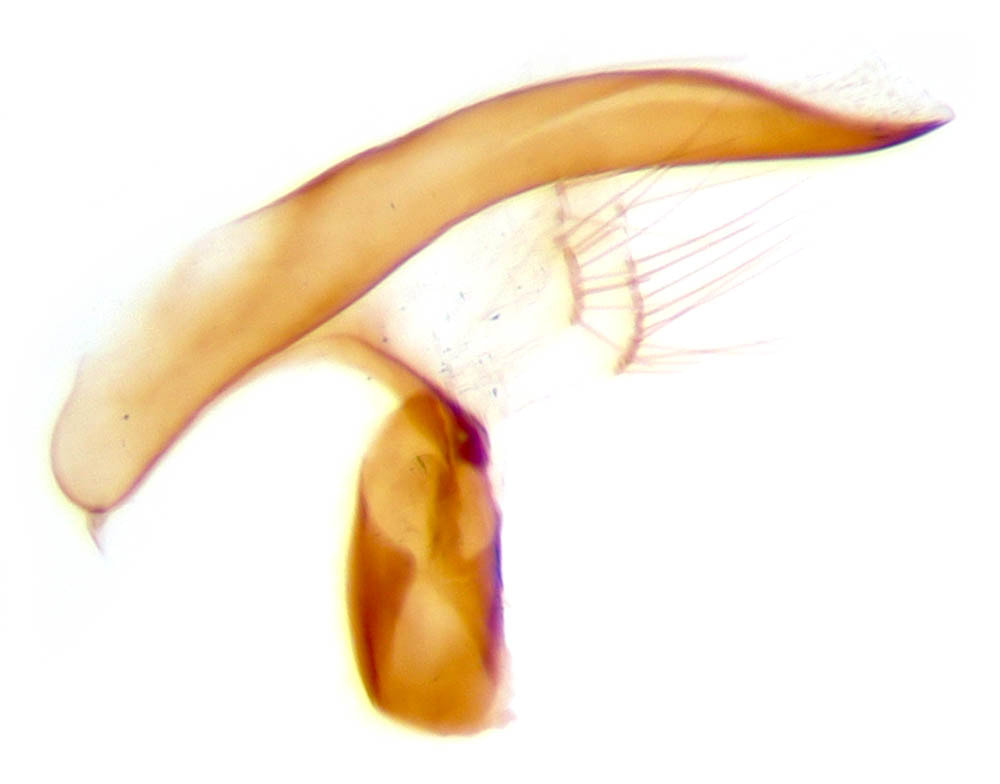49.053 Cnephasia pumicana (Cereal Tortrix) |
I am currently persuaded that this is not a valid taxon
C.pumicana and C.pasuiana were synonymised (as C.pasuiana) until 2010 when they were split following publication of a paper in the Entomologist's Record (122:4) by Langmaid and Agassiz.
These two "species" are indistinguishable on external features (as for most Cnephasia species).
The declaration of this split was based on examination of the genitalia and a finding of "consistent differences between these taxa".
According to Lepiforum, there are minor biological differences, notably with C.pasiuana feeding on a wide range of herbaceous plants and C.pumicana largely confined the Poaceae (hence the English name "Cereal Tortrix").
There follows an appraisal of the proposed male genital features used in distinguishing the two "species".
A study of the many images of both "species" shown at Moth Dissection leads to a clear impression of considerable and overlapping variability for all the features listed. It is notable that the Ent Rec paper gives absolutely no indication of the range of variability found by the authors and presents what appear to be examples at the extreme ends of a continuous range as being typical of each "species".
In both "species" the sacculus is of medium length, 1/2-2/3 the length of the valva, and curved at the end.
C.communana also has a medium length sacculus but it has a straight aedeagus while in C.pasiuana/pumicana the aedeagus is curved.
According to the Entomologists Record paper "the most constant distinguishing feature is the length and shape of the aedeagus".
This is actually two features, and a number of further and presumably less constant features are also given. These features are listed below with my comments in purple.
1. Length of the aedeagus: that of C.pumicana being about ⅔ the length of that of C.pasiuana
Comparing the length of the aedeagus requires similarly prepared specimens with the aedeagus either detached or set exactly in lateral view. Personal correspondence with David Agassiz has informed me that the assessment was not based on any actual measurement of the aedeagus. Presumably then the statement is based on a general impression of the length of the aedeagus relative to the genitalia as a whole. This seems far too subjective to be acceptable as one of the most constant features giving rise to acceptance of a "new species". If the aedeagus of C.pasiuana truly is longer, then an absolute distinction should be determinable from the ratio of lengths of the aedeagus to another structure - the sacculus being the most obvious comparator. Applying the aedeagus: sacculus length ratio to the images at Moth Dissection (7 images of each species) gives: C.pumicana 0.92 - 1.05 and C.pasiuana 0.87 - 1.02. I conclude that, on the information available to me, it cannot be reliably demonstrated that the aedeagus of C.pasiuana is longer and that if anything that of images labelled C.pumicana averages longer when the sacculus is used as a comparator. (Or that the split into two species is not valid, or that some images at Moth Dissection have been inappropriately identified),
2. Shape of the aedeagus: gently curved in C.pumicana; bent at ⅓ from the apex in C.pasiuana
This may provide an absolute distinction where it can be judged with confidence, but judging from the images at Moth Dissection there is a range of variation in each species and it may not usually be possible to make a confident judgement. In particular the gentle curve in C.pumicana very often shows a degree of angulation that could be interpreted as a bend. It is also necessary to ensure that the aedeagus is not bent as an artefact during slide preparation and that the aedeagus is presented in lateral view - any rotation will tend to diminish the apparent degree of curvature (and I have noted for future investigation to consider whether the apparent difference giving rise to the perception of two taxa could be entirely due to differences in the rotation of the aedeagus). The angle between that part of the aedeagus basal to the curve/bend and the part apical to the curve/bend ranges from 120-150° in both species (as measured from images at Moth Dissection). It is the abruptness with which the angulation occurs that is supposed to be relevant (and not the degree of curvature) - and there is no absolute way of determining this.
3. Cucullus: "rounded" in C.pasiuana, "pointed" in C.pumicana
This refers to the apex of the valva, which shows no differentiation of a cucullus in Cnephasia species and is rounded in both "species". The actual distinction being proposed is that the apical rounding is more acute in C.pumicana, and that the apex is broader in C.pasiuana. This distinction is fairly clear in some of the images at Moth Dissection, though again the broadness of the apex is variable in both species. As a rough guide the angle between the edges in the apical half of the valva is ~30° in C.pumicana and ~40° in C.pasiuana. Personal correspondence with Peter Hall suggests that he finds this a more convincing discriminator (so that some specimens at Moth Dissection have been allocated to species based on valval shape rather than aedeagal shape - hence my ability to measure a difference). My impression though is that there is a continuous range of variation and that it is not strictly dichotomous.
4. Gnathos: arms broader and tip larger in C.pasiuana
"Tip" refers to the median lobe. The differences are marginal but the gnathos arms do appear comparatively broad in 3 of the 8 images of C.pasiuana at Moth Dissection. The median lobe is almost invariably distorted during slide preparation making judgement on this feature unreliable.
5. Apex of sacculus: more abruptly curved in C.pasiuana
This is difficult to judge as the abruptness of the curvature increases with degree of compression and is impossible to demonstrate without compression. There is no convincing difference between the species on this feature when comparing the set specimens at Moth Dissection.
6. Fold of sacculus: extends <½ length of sacculus in C.pasiuana; >½ length in C.pumicana
This refers to a carina on the apical portion of the sacculus. This feature should provide an absolute means of distinguishing the species - if it can be accurately identified and if the distinction were valid.
7. Caulis: thick in C.pasiuana, thin in C.pumicana
This refers to the "stalk" attaching the aedaegus to the juxta, which is inevitably distorted/disrupted in detaching the aedeagus or setting it in a lateral position. This does not seem to provide a convincing means of distinction.
A further feature indicated in an image (by Langmaid) at Moth Dissection is that the socii are widely spaced in C.pasiuana and much closer together in C.pumicana; but other images show much variability in this feature in both species and this is almost certainly due to variations in degree of compression of the specimen, with wider spacing resulting from greater flattening of the tegumen with greater compression.
A feature mentioned at Lepiforum is that the apex of the aedeagus of C.pasiuana has a lobe-like extension, but this feature is also seen in some of the Moth Dissection images labelled as C.pumicana and is absent from 3 of the images labelled as C.pasiuana.
There are also small, even less convincing, differences in the female genitalia proposed in the Ent Rec paper. I am informed that John Langmaid had later confessed to doubt about the validity of these differences
In conclusion - I do not believe that the evidence provided in this paper meets the academic standard required for acceptance of a new species. I will therefore not recognise C.pumicana as a valid taxon until / unless some more convincing evidence can be provided.
For those who wish to continue to recognise the split, the features listed below may allow specimens displaying features at the extremes of the range of variation to be allocated to one or other taxon.
C.pumicana: aedeagus evenly curved; valval apex narrowly rounded
C.pasiuana: aedeagus distinctly bent at ⅓ from apex; valval apex broadly rounded
These two "species" are indistinguishable on external features (as for most Cnephasia species).
The declaration of this split was based on examination of the genitalia and a finding of "consistent differences between these taxa".
According to Lepiforum, there are minor biological differences, notably with C.pasiuana feeding on a wide range of herbaceous plants and C.pumicana largely confined the Poaceae (hence the English name "Cereal Tortrix").
There follows an appraisal of the proposed male genital features used in distinguishing the two "species".
A study of the many images of both "species" shown at Moth Dissection leads to a clear impression of considerable and overlapping variability for all the features listed. It is notable that the Ent Rec paper gives absolutely no indication of the range of variability found by the authors and presents what appear to be examples at the extreme ends of a continuous range as being typical of each "species".
In both "species" the sacculus is of medium length, 1/2-2/3 the length of the valva, and curved at the end.
C.communana also has a medium length sacculus but it has a straight aedeagus while in C.pasiuana/pumicana the aedeagus is curved.
According to the Entomologists Record paper "the most constant distinguishing feature is the length and shape of the aedeagus".
This is actually two features, and a number of further and presumably less constant features are also given. These features are listed below with my comments in purple.
1. Length of the aedeagus: that of C.pumicana being about ⅔ the length of that of C.pasiuana
Comparing the length of the aedeagus requires similarly prepared specimens with the aedeagus either detached or set exactly in lateral view. Personal correspondence with David Agassiz has informed me that the assessment was not based on any actual measurement of the aedeagus. Presumably then the statement is based on a general impression of the length of the aedeagus relative to the genitalia as a whole. This seems far too subjective to be acceptable as one of the most constant features giving rise to acceptance of a "new species". If the aedeagus of C.pasiuana truly is longer, then an absolute distinction should be determinable from the ratio of lengths of the aedeagus to another structure - the sacculus being the most obvious comparator. Applying the aedeagus: sacculus length ratio to the images at Moth Dissection (7 images of each species) gives: C.pumicana 0.92 - 1.05 and C.pasiuana 0.87 - 1.02. I conclude that, on the information available to me, it cannot be reliably demonstrated that the aedeagus of C.pasiuana is longer and that if anything that of images labelled C.pumicana averages longer when the sacculus is used as a comparator. (Or that the split into two species is not valid, or that some images at Moth Dissection have been inappropriately identified),
2. Shape of the aedeagus: gently curved in C.pumicana; bent at ⅓ from the apex in C.pasiuana
This may provide an absolute distinction where it can be judged with confidence, but judging from the images at Moth Dissection there is a range of variation in each species and it may not usually be possible to make a confident judgement. In particular the gentle curve in C.pumicana very often shows a degree of angulation that could be interpreted as a bend. It is also necessary to ensure that the aedeagus is not bent as an artefact during slide preparation and that the aedeagus is presented in lateral view - any rotation will tend to diminish the apparent degree of curvature (and I have noted for future investigation to consider whether the apparent difference giving rise to the perception of two taxa could be entirely due to differences in the rotation of the aedeagus). The angle between that part of the aedeagus basal to the curve/bend and the part apical to the curve/bend ranges from 120-150° in both species (as measured from images at Moth Dissection). It is the abruptness with which the angulation occurs that is supposed to be relevant (and not the degree of curvature) - and there is no absolute way of determining this.
3. Cucullus: "rounded" in C.pasiuana, "pointed" in C.pumicana
This refers to the apex of the valva, which shows no differentiation of a cucullus in Cnephasia species and is rounded in both "species". The actual distinction being proposed is that the apical rounding is more acute in C.pumicana, and that the apex is broader in C.pasiuana. This distinction is fairly clear in some of the images at Moth Dissection, though again the broadness of the apex is variable in both species. As a rough guide the angle between the edges in the apical half of the valva is ~30° in C.pumicana and ~40° in C.pasiuana. Personal correspondence with Peter Hall suggests that he finds this a more convincing discriminator (so that some specimens at Moth Dissection have been allocated to species based on valval shape rather than aedeagal shape - hence my ability to measure a difference). My impression though is that there is a continuous range of variation and that it is not strictly dichotomous.
4. Gnathos: arms broader and tip larger in C.pasiuana
"Tip" refers to the median lobe. The differences are marginal but the gnathos arms do appear comparatively broad in 3 of the 8 images of C.pasiuana at Moth Dissection. The median lobe is almost invariably distorted during slide preparation making judgement on this feature unreliable.
5. Apex of sacculus: more abruptly curved in C.pasiuana
This is difficult to judge as the abruptness of the curvature increases with degree of compression and is impossible to demonstrate without compression. There is no convincing difference between the species on this feature when comparing the set specimens at Moth Dissection.
6. Fold of sacculus: extends <½ length of sacculus in C.pasiuana; >½ length in C.pumicana
This refers to a carina on the apical portion of the sacculus. This feature should provide an absolute means of distinguishing the species - if it can be accurately identified and if the distinction were valid.
7. Caulis: thick in C.pasiuana, thin in C.pumicana
This refers to the "stalk" attaching the aedaegus to the juxta, which is inevitably distorted/disrupted in detaching the aedeagus or setting it in a lateral position. This does not seem to provide a convincing means of distinction.
A further feature indicated in an image (by Langmaid) at Moth Dissection is that the socii are widely spaced in C.pasiuana and much closer together in C.pumicana; but other images show much variability in this feature in both species and this is almost certainly due to variations in degree of compression of the specimen, with wider spacing resulting from greater flattening of the tegumen with greater compression.
A feature mentioned at Lepiforum is that the apex of the aedeagus of C.pasiuana has a lobe-like extension, but this feature is also seen in some of the Moth Dissection images labelled as C.pumicana and is absent from 3 of the images labelled as C.pasiuana.
There are also small, even less convincing, differences in the female genitalia proposed in the Ent Rec paper. I am informed that John Langmaid had later confessed to doubt about the validity of these differences
In conclusion - I do not believe that the evidence provided in this paper meets the academic standard required for acceptance of a new species. I will therefore not recognise C.pumicana as a valid taxon until / unless some more convincing evidence can be provided.
For those who wish to continue to recognise the split, the features listed below may allow specimens displaying features at the extremes of the range of variation to be allocated to one or other taxon.
C.pumicana: aedeagus evenly curved; valval apex narrowly rounded
C.pasiuana: aedeagus distinctly bent at ⅓ from apex; valval apex broadly rounded
|
These examples illustrate some of the difficulty. The aedeagi have an angulation that could be interpreted as a bend at ⅓ from their apices. The apex of the valva is borderline in the example above and distinctly narrow in the example below. The apical saccular carina (if I have identified it correctly - shown as a green line above) clearly extends into the basal half of the sacculus in both specimens. In the example below a lesser degree of compression has been applied than in the example above - the appearance of a less downturned apex to the sacculus is entirely due to this difference in preparation.
|
The second specimen has a valval apex that is narrower than any images of C.pasiuana and should therefore be C.pumicana. Its aedeagus is bent to the same degree in both specimens suggesting that for a specimen to be acceptable as C.pasiuana the aedeagus must be bent to a greater degree than is shown here. Most of the images at Moth Dissection labelled as C.pasiuana do not show a greater degree of bend.
Page published 13/08/2023
